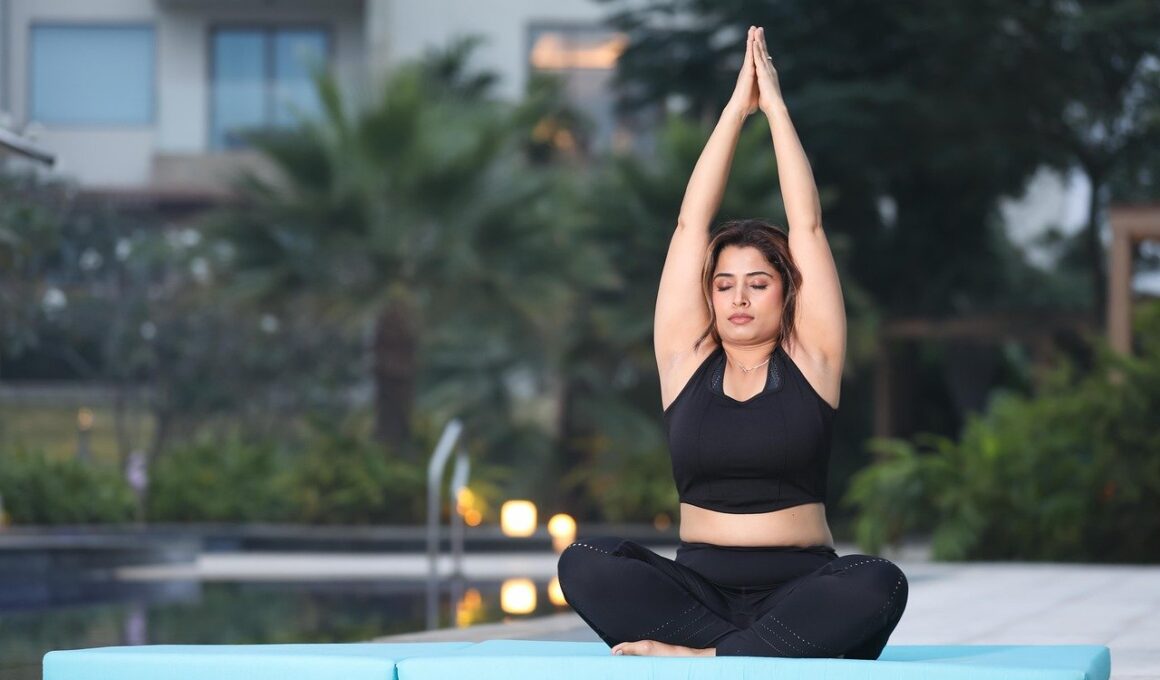Balancing Act: Combining Mindfulness with Physical Training
In an age where multitasking is prevalent, integrating mindfulness into physical training can enhance one’s overall balance and coordination. This approach promotes a deep awareness of body movements and mental states, creating a synergy between mind and body. Mindfulness practices, such as meditation and conscious breathing, can ground individuals, allowing them to become more attuned to their physical sensations. When engaged in movement, being mindful can lead to improved performance and reduced risk of injury. Sessions that incorporate both mindfulness and physical training encourage individuals to focus on their inner experiences and reactions, transforming workouts into holistic routines. By cultivating this awareness, practitioners can achieve improved proprioception—the sense of body positioning. Losing oneself in movement without distractions can result in a form of meditation in motion, which provides unique benefits. Furthermore, the incorporation of mindfulness establishes a more enjoyable atmosphere for training, leading to greater persistence and motivation. Physical activities, when paired with mindfulness, can help individuals unlock greater potential and resilience, ultimately enhancing both balance and coordination. Individuals will find it easier to connect mentally and physically, allowing for a more fulfilling exercise experience.
Engaging in various forms of exercise encourages not only physical fitness but also mental clarity. When we participate in a workout or activity that emphasizes mindfulness, focus shifts from external distractions to internal awareness. This benefits concentration significantly, enhancing the ability to maintain balance and stability during movement. Techniques such as yoga and tai chi are perfect examples of physical practices incorporating mindfulness principles seamlessly. These activities promote fluid motion, mindfulness, and intentionality, fostering better body awareness and control. Engaging in workouts that emphasize alignment and breath can further improve coordination and improve overall biomechanics. Stakeholders in fitness, such as trainers and coaches, can also benefit from incorporating mindfulness exercises. They can help clients become aware of their mental states will enhancing their physical capabilities. Regular mindfulness practices paired with physical training can lead to profound self-discovery and personal growth. Through mindfulness, athletes can better understand their limits and capabilities. This awareness is crucial in sports and physical activities as it directly impacts performance. As a result, individuals become more capable of performing at their maximum level, leading to increased satisfaction in their training.
The Science Behind Mindfulness and Performance
Scientific research shows that mindfulness enhances athletic performance in various ways. Studies suggest that individuals who practice mindfulness experience greater focus and improved mental resilience, making them better suited to handle challenges during training and competition. When athletes can minimize distractions, they can interpret situations and adapt their movements better. There’s also evidence that mindfulness tends to elevate individuals’ tolerance for discomfort and fatigue, crucial traits in demanding physical training scenarios. This psychological edge allows athletes to push their limits while maintaining proper form and technique. The brain’s neuroplasticity supports this by creating new pathways that enhance one’s skills through consistent mindful training. Furthermore, the stress reduction attributed to mindfulness practices leads to increased relaxation during performance. When individuals feel calm, their bodies are more aligned, enabling them to execute movements with precision. Balancing mental and physical practices through mindfulness can also limit the impact of negative self-talk and doubt, fostering a more positive and constructive mindset. As a result, athletes can develop an unwavering commitment to their physical training, thus contributing to overall improvements in balance and coordination. This integration results in comprehensive training, developing both the body and mind.
Incorporating mindfulness techniques into workouts can take many forms. Individuals can begin their training sessions with a few minutes of meditation to set intentions and foster concentration. Visualization techniques can be employed, where practitioners imagine themselves executing movements effectively. Appreciating the rhythm of breath can further enhance coordination during activities, making movements more efficient and purposeful. Fitness classes can also emphasize mindful approaches by integrating slow-paced methods that require participants to focus on their form and alignment. Activities such as Pilates, yoga, or martial arts can create a mindful training atmosphere, allowing practitioners to cultivate these skills over time. In this context, exercises that promote static and dynamic balance can significantly benefit from mindfulness. Participants learn to be aware of their body positioning and react to changes while executing moves, improving overall coordination. Furthermore, adopting mindfulness during cool-down and stretching routines fosters relaxation and aids recovery. This time can be a valuable moment to reflect on the session’s progress and accomplishments, solidifying the connection between mental clarity and physical capability. As a result, the synergy cultivated through these integrated practices amplifies both the mind’s and body’s potential.
Practical Tips for Implementation
To start combining mindfulness with physical training, consider adopting a few simple strategies. First, dedicate specific sessions solely to mindfulness, creating a routine that allows for practice without distractions. Engaging in mindful walks, where focus is placed on each step and breath, offers an excellent gateway for awareness in other physical activities. Additionally, during workouts, strive to periodically pause and reconnect with your breath and body, noticing sensations as they arise. Visualization can empower training outcomes; by envisioning specific goals, you can set yourself up for success. Practices such as journaling post-workout can allow for reflection on experiences, fostering a growth mindset. It can also aid in recognizing achievements, no matter how small, reinforcing positive behavior. Participate in group classes focused on mindful movement to enjoy the social aspect while benefiting from community support. Building a supportive network encourages ongoing practice and accountability. Furthermore, always remember the importance of variety in training—experimenting with different mindful exercises will prevent stagnation and reinforce engagement. Ultimately, these practical tips aim to create a training environment where mindfulness becomes an integral, enjoyable part of physical development.
As balance and coordination improve through mindfulness techniques, self-confidence is naturally enhanced. With heightened awareness comes an improved understanding of one’s body. This leads to a better ability to anticipate and respond to physical challenges, which results in feeling capable and in control. When individuals notice personal growth in their balance and coordination, they may seek more advanced forms of physical activity. This motivates them to pursue new goals and challenges, further activating their physical potential. Participating in advanced activities, such as dance or team sports, can deepen this newfound confidence, as individuals feel more equipped to engage with dynamic movements. Moreover, the intersection of mindfulness within these experiences fosters a supportive atmosphere that elevates self-esteem and encourages camaraderie among peers. Establishing common interests solidifies connections with others, enhancing the enjoyment derived from physical training. Having a diverse range of physical abilities can further stimulate the mind and body relationship, allowing individuals to experiment and develop new skills. The cycle of growth continues as they explore their capacities. Consequently, their journey becomes richer, leading to more satisfying and rewarding workouts, paving the way for lifelong health and wellness.
Conclusion: Embracing the Unity of Mind and Body
In embracing mindfulness as a tool for enhancing balance and coordination through physical training, individuals open themselves to a holistic fitness journey. Mindfulness not only thrives in physical activity but also enriches everyday life by promoting mental clarity, resilience, and emotional stability. Integrating mindfulness practices into training sessions fosters a unique awareness that sharpens focus and improves performance. As participants experience the cognitive and physical benefits, they may inspire others to embrace this enriching practice. Engaging meaningfully with the mind-body connection nurtures personal growth and self-discovery. Mindfulness transforms physical training into moments of presence and joy, allowing individuals to fully appreciate their capabilities. As they refine their skills, it can foster a greater appreciation for the journey of continual improvement. Recognizing that balance is a lifelong pursuit encourages practitioners to explore various forms of mindful physical activities, nurturing adaptability and resilience. Ultimately, the combination of mindfulness and physical training serves as a powerful foundation for sustaining a healthy lifestyle. Balance and coordination are more than just fitness goals; they are reflections of a harmonious connection that enriches one’s life.
Even as this journey unfolds, staying committed requires patience and motivation. Appreciating the gradual progress can assist in maintaining enthusiasm and resilience. Embracing mindfulness in all physical endeavors allows for a more profound exploration of abilities and personal fulfillment. Balancing mind and body creates a sense of wholeness that manifests in various areas of life, enhancing overall well-being. With time, individuals will discover their unique paths toward achieving greater balance and coordination, ultimately fostering an inclusive approach to fitness that connects them with their bodies. Through this journey of personal growth, individuals can marvel at how mindfulness will transform their relationship with exercise, embracing movement as an expression of vitality and joy.


